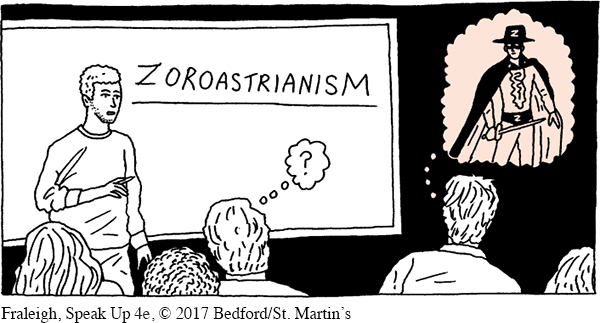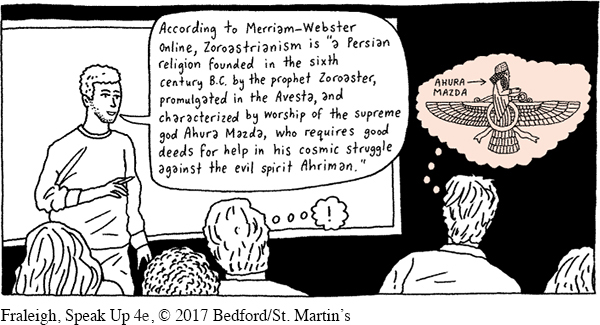Definitions
When you introduce new information to audience members, you might use terms unfamiliar to them. If you don’t take time to define these terms, your listeners may have difficulty understanding your message, which can leave them feeling frustrated.

Page 235

For example, suppose you’re preparing an informative speech on the Persian empire, and you want to explain that the Persians practiced a religion called Zoroastrianism. This term will probably be new to your audience, so you’ll need to define it. There are several different types of definitions you could use:
A dictionary definition provides the meaning of a term as presented in a dictionary. You might use a general dictionary (such as Merriam-
Webster) or, if available, a specialized dictionary for your topic. For example, “According to Cambridge Dictionaries Online, Zoroastrianism is ‘a religion which developed in ancient Iran, and is based on the idea that there is a continuous fight between a god who represents good and one who represents evil.’”10 An expert definition comes from a person who is a credible source of information on your topic. For example, “According to Mary Boyce, professor of Iranian studies at the University of London, Zoroastrians believe that ‘there is a supreme God who is the creator; that an evil power exists which is opposed to him, and not under his control.’”11
An etymological definition explains the linguistic origin of the term. This type of definition is appropriate when the origin is interesting or will help the audience understand the term. For example, “Zoroastrianism has been so named in the West because its prophet, Zarathustra, was known to the ancient Greeks as Zoroaster.12 Zoroastrians believe that Ahura Mazda (God) revealed the truth through Zarathustra.”
Page 236
A functional definition explains how something is used or what it does. For instance, a speaker might define Zoroastrianism in terms of how it is practiced by its followers: “According to the Ontario Consultants on Religious Tolerance, Zoroastrian worship ‘includes prayers and symbolic ceremonies.’ Rituals ‘are conducted before a sacred fire. . . . [Practitioners] regard fire as a symbol of their God.’”13